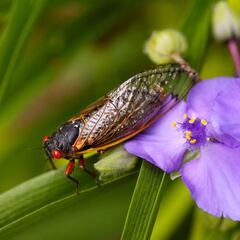What are the differences between brood XIX and brood XIII cicadas?
This year there will be a co-emergence of trillions of cicadas from two periodical broods in the United States in what is being dubbed ‘cicada-geddon’.

Just about every summer one of the most audible bugs, cicadas, can be heard enticing a mate with its over-the-top buzzing sound, which can be as loud as a lawnmower. That means even when their numbers are small they make their presence well-known.
This year however, large swaths of the United States will be inundated with the sound of the bulgy-eyed bugs as two separate broods will come out of their burrows this spring. This co-emergence of brood XIX and brood XIII, which last happened 221 years ago, has been dubbed ‘cicada-geddon’. It will be especially true for those that live in parts of Illinois where the two co-exist.
What are the differences between brood XIX and brood XIII cicadas?
Cicadas are generally divided into two groups, annual and periodical. While the annuals emerge throughout the summer from their burrows after spending two to five years, sometimes more, underground, the 15 groups of active periodicals like to come out en masse, and turn up the volume.
The largest of the three 13-year periodical cicada broods by geographically extent, Brood XIX, also known as ‘The Great Southern Brood’, began emerging in late-April. It is made up of four separate species of cicadas according to the University of Connecticut.
13-year cicada broods generally have their geographical territorial range in the south. But brood XIX also has a solid presence across Missouri as well as southern and central Illinois.
In 2024, members of brood XIX in central Illinois will be co-mingling with members of brood XIII. This group of cicadas comes out once every 17 years and the last time the two broods were together was in 1803, when Thomas Jefferson was the US president.
Cicadas ahead of schedule, expected soon in Chicago area https://t.co/f1ww6jBUG2
— WGN TV News (@WGNNews) April 30, 2024
Brood XIII, also known as ‘The Northern Illinois Brood’, is made up of three other species of cicadas. It has “one of the largest and best documented off-cycle or ‘straggling’ emergence[s]” according to the University of Connecticut.
While the two broods may consist of seven different species of cicadas, they will be making a similar racket like no other and it will be impossible to distinguish between one or another. Likewise, the appearance of periodical cicadas is similar as well.
Periodical cicadas in general have black backs, orange undersides, red eyes and are just over an inch in length. Their wings are clear and membranous with black veins with a span of roughly three inches.
Related stories
While there may be anywhere from 50,000 to 1.5 million of the critters per single square acre, there is no need to worry about most of your plants nor your body. Except for giving many the creepy crawlies, the noisy revelers don’t bite humans or animals as they are herbivores.
As for your trees and plants, they don’t eat vegetation and generally don’t irreparably damage trees. They suck on the juices in trees and make slits in branches to lay their eggs, but excessive numbers may overwhelm young trees, which can be protected by shrouding them in a net.



Complete your personal details to comment